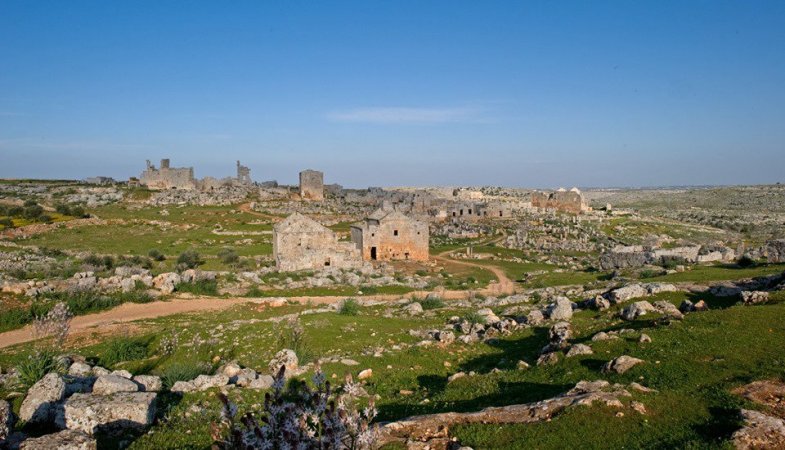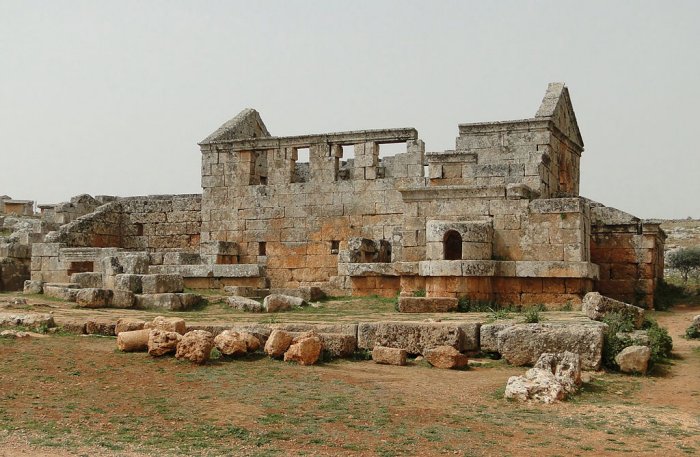Dead City Of Serjilla – Byzantine Village In Syria Struggling To Survive The Middle Of A War Zone
Jan Bartek – AncientPages.com – In a country like Syria where ongoing conflicts have destroyed many significant ancient historical buildings and artifacts, it’s a relief to see these old ruins that are still standing more or less intact in the middle of a war zone.
Serjilla is located not far from Aleppo in Syria. Credit: Manar al Athar, University Of Oxford
The Byzantine village of Serjilla is one of the best-preserved of the “Dead Cities” in Syria. Serjilla has survived earthquakes, foreign invasions and one wonders how much longer these Byzantine ruins will last without being smashed to pieces.
Will The Byzantine Village Serjilla Survive Syria's Modern Conflict?
The remains of this Byzantine settlement are located in the Jebel Riha, approximately 65 km north from Hama and 80 km southwest from Aleppo. It’s a sensitive region where intense battles between the Syrian army and rebels are fought regularly.
Several cultural sites have already been damaged or destroyed by war and no one knows whether Serjilla can endure this modern conflict.
A view of the Byzantine ruins. Credit: Heretiq, CC BY-SA 2.5
Syria was once home to a great and powerful ancient empire. It contained many beautiful “flourishing cities set in a densely populated countryside whose inhabitants built churches and houses of elegantly carved stone. In the sixth century, the country suffered an unparalleled series of disasters in the form of earthquakes, plague, and foreign invasion.
Early in the seventh century, it passed under the control of Persians, who had barely left when the victorious armies of Islam definitely removed it from the orbit of Constantinople and Christianity. This was not the end, but the beginning of another glorious epoch in which Syria became the center of a vast empire famed for its great cities and monuments.” 1
Syria is a country with a rich and interesting history, but its past glory is long gone. Now it no longer a matter of power and prestige but survival. Though few think about Serjilla this small Byzantine village still stands there awaiting its verdict.
See also:
Ashur – First Capital And Powerful Religious Center Of The Assyrian Empire
Tiglath Pileser III: Neo-Assyria’s Strong King Who Built A Mighty Empire
Remarkable Ancient Statues From The Eye Temple – Unique Legacy From Tell Brak, Syria
The ruined Byzantine settlements of Mujleya, Btirsa, Bshilla, Ba’uda, Dalloze, Serjilla, Rabi’ah and Shinshara (also called Khirbet Hass) are all part of the World Heritage Site called the Ancient Villages of Northern Syria, inscribed in 2011 and composed of eight archaeological parks.
Today, many remain in an exceptional state of preservation, particularly Serjilla; some buildings still have two stories, and much of the surrounding cultural landscape is also preserved, including some field boundaries, wine presses, and other such installations.
Satellite-based damage assessment to historical sites in Syria revealed that “Shinshara, Rabi’ah and Serjilla have apparently been resettled, potentially by civilians who are seeking refuge from conflict.
Ruins of the Church in Serjilla. Credit: Bernard Gagnon, CC BY-SA 3.0
The exceptional level of preservation of the Dead Cities provides shelter not only from the shelling, which often occurs in the area, but also from the harsh winters. In addition to building makeshift shelters, many refugees dig beneath the ruins for refuge.
These Dead Cities have become home to thousands of refugees who have fled from the civil war and now live in the caves beneath the ruins.
Some have even dug up the ancient stone graves and are using them as makeshift homes. There is little or no access to places like this while war rages, so the true nature of the devastation will not be known for some time.
In some cases, particularly where a Dead City has been resettled, there is the potential for looting to occur. “People are not only using these ghost towns as a place to live, but also as a way to make a living. Minor looting has been reported at AlBara, but the extent of the damage done to the reviewed sites cannot be confirmed beyond the presence of civilian activity.” 2
Remains Of Beautiful Roman Baths In Serjilla
Serjilla was built around 473 A.D. The Byzantine village arose in a natural basin and prospered from cultivating grapes and olives. Archaeological discoveries support the theory that Serjilla’s ancient inhabitants were wealthy.
Scientists have found beautiful remains of Roman baths, extensive remains of houses, and impressive terraces that show how prosperous this region once was. The church at Serjilla dates back to 372 A.D. and is considered one of the oldest in the region.
Public baths in Serjilla. Credit: Bernard Gagnon, CC BY-SA 3.0
A large mosaic was also unearthed in the main meeting hall of the baths, but it has now been destroyed. When the Arabs conquered the region, Serjilla and the other Dead Cities were abandoned.
All that is left are the ancient ruins of the two-story villa, public baths, the Church, and the press- house. Only time can tell whether the Byzantine village Serjilla will survive Syria’s modern conflict.
Written by Jan Bartek - AncientPages.com Staff Writer
Copyright © AncientPages.com All rights reserved. This material may not be published, broadcast, rewritten or redistributed in whole or part without the express written permission of AncientPages.com
Expand for references- Foss, Clive. "Syria in Transition, A. D. 550-750: An Archaeological Approach." Dumbarton Oaks Papers51 (1997): 189-269. Accessed January 25, 2020. doi:10.2307/1291765.
- UNESCO - Satellite-based Damage Assessment to Cultural Heritage Sites in Syria
More From Ancient Pages
-
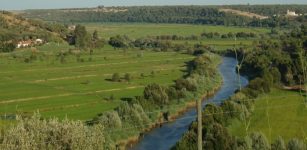 Mummification In Europe May Be Older Than Previously Known – 8,000-Year-Old Evidence Presented
Archaeology | Mar 4, 2022
Mummification In Europe May Be Older Than Previously Known – 8,000-Year-Old Evidence Presented
Archaeology | Mar 4, 2022 -
 Bizarre Meat-Eating Dinosaur Found In Classic Fossil Site In Egypt’s Sahara Desert
Archaeology | Jun 9, 2022
Bizarre Meat-Eating Dinosaur Found In Classic Fossil Site In Egypt’s Sahara Desert
Archaeology | Jun 9, 2022 -
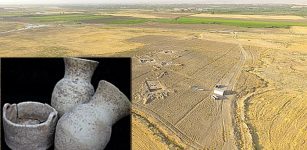 Mesopotamian People Liked To Drink Beer Using Variety Of Drinking Vessels
Archaeology | Jun 28, 2018
Mesopotamian People Liked To Drink Beer Using Variety Of Drinking Vessels
Archaeology | Jun 28, 2018 -
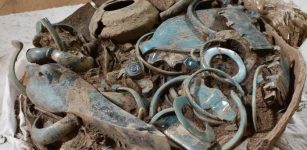 Hundreds Of Exceptional Bronze Age Artifacts Discovered In France Were Probably Offerings
Archaeology | Aug 28, 2021
Hundreds Of Exceptional Bronze Age Artifacts Discovered In France Were Probably Offerings
Archaeology | Aug 28, 2021 -
 Was Aztec And Mixtec Turquoise Mined In the American Southwest?
Archaeology | Jun 15, 2018
Was Aztec And Mixtec Turquoise Mined In the American Southwest?
Archaeology | Jun 15, 2018 -
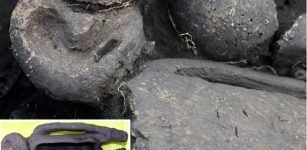 Never-Before-Seen Strange 5,000-Year-Old Clay Figurine With A Tattooed Face And Bone Mask Found In Siberia
Archaeology | Oct 2, 2020
Never-Before-Seen Strange 5,000-Year-Old Clay Figurine With A Tattooed Face And Bone Mask Found In Siberia
Archaeology | Oct 2, 2020 -
 Was There An Explosion In The Great Pyramid In Antiquity?
Featured Stories | Aug 6, 2014
Was There An Explosion In The Great Pyramid In Antiquity?
Featured Stories | Aug 6, 2014 -
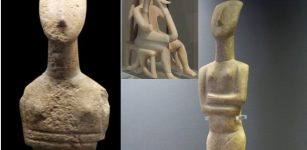 The Cyclades And Their Advanced And Mysterious Society Lost In Time
Featured Stories | Apr 25, 2022
The Cyclades And Their Advanced And Mysterious Society Lost In Time
Featured Stories | Apr 25, 2022 -
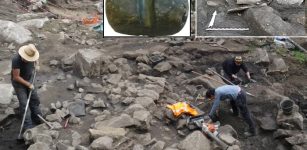 6,000-Year-Old Vast Settlement With Tools And Granite Structures Unearthed In Sotta, Corsica In France
Archaeology | May 16, 2023
6,000-Year-Old Vast Settlement With Tools And Granite Structures Unearthed In Sotta, Corsica In France
Archaeology | May 16, 2023 -
 Strange Case Of The Vampire Doctor And The Dark Figure Remains Unexplained
Featured Stories | Oct 6, 2024
Strange Case Of The Vampire Doctor And The Dark Figure Remains Unexplained
Featured Stories | Oct 6, 2024 -
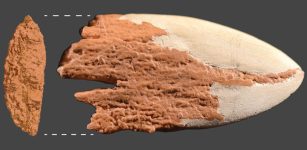 Evidence Oldest Bone Spear Point In The Americas Is 13,900 Years Old
Archaeology | Feb 3, 2023
Evidence Oldest Bone Spear Point In The Americas Is 13,900 Years Old
Archaeology | Feb 3, 2023 -
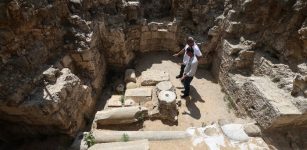 Large Ancient Roman Necropolis Is Buried Beneath The Gaza Strip – Can It And Other Ancient Treasures Be Saved?
Archaeology | Jun 26, 2022
Large Ancient Roman Necropolis Is Buried Beneath The Gaza Strip – Can It And Other Ancient Treasures Be Saved?
Archaeology | Jun 26, 2022 -
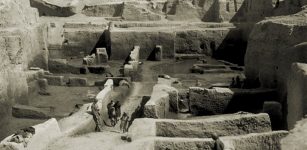 Iraq’s Ancient Kish City Survived The Great Flood – Today It’s Neglected And Lies Buried In Sand
Civilizations | Sep 24, 2015
Iraq’s Ancient Kish City Survived The Great Flood – Today It’s Neglected And Lies Buried In Sand
Civilizations | Sep 24, 2015 -
 Rare Bes Mugs Reveal Ancient Egyptians Drank Hallucinogenic Cocktails During Rituals
Archaeology | Nov 18, 2024
Rare Bes Mugs Reveal Ancient Egyptians Drank Hallucinogenic Cocktails During Rituals
Archaeology | Nov 18, 2024 -
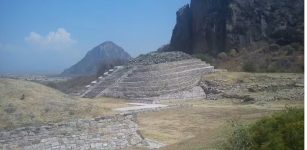 What Can Monument 9 Reveal About The Mysterious Olmec Civilization?
Featured Stories | Jun 30, 2023
What Can Monument 9 Reveal About The Mysterious Olmec Civilization?
Featured Stories | Jun 30, 2023 -
 Kahina – The Prophetic Berber Queen Who Resisted The Muslim Invasions Of The Numidia Kingdom
Featured Stories | Aug 14, 2021
Kahina – The Prophetic Berber Queen Who Resisted The Muslim Invasions Of The Numidia Kingdom
Featured Stories | Aug 14, 2021 -
 Mysterious City Lost In The Sands And Its Hidden Treasures
Ancient Mysteries | May 21, 2018
Mysterious City Lost In The Sands And Its Hidden Treasures
Ancient Mysteries | May 21, 2018 -
 Ancient Reptilian-Like Humanoids Hold Secrets Of Mankind’s Origin
Ancient Mysteries | Apr 12, 2014
Ancient Reptilian-Like Humanoids Hold Secrets Of Mankind’s Origin
Ancient Mysteries | Apr 12, 2014 -
 Sacred ‘Sign Posts’ Of The Inuit People
Ancient History Facts | Sep 4, 2018
Sacred ‘Sign Posts’ Of The Inuit People
Ancient History Facts | Sep 4, 2018 -
 Strange Story Of Tecumseh’s Comet, Black Sun Prophecy And New Madrid Earthquakes – The Biggest Earthquakes In American History
Ancient Mysteries | Nov 14, 2018
Strange Story Of Tecumseh’s Comet, Black Sun Prophecy And New Madrid Earthquakes – The Biggest Earthquakes In American History
Ancient Mysteries | Nov 14, 2018

